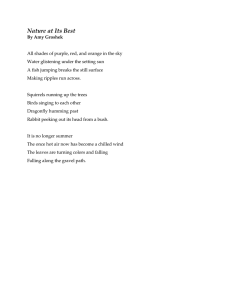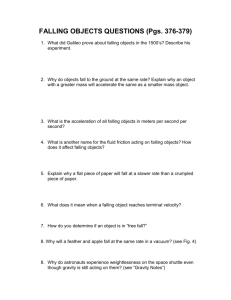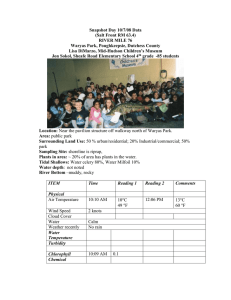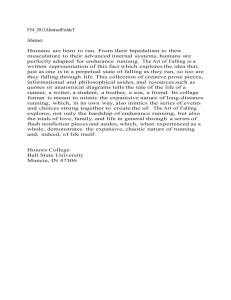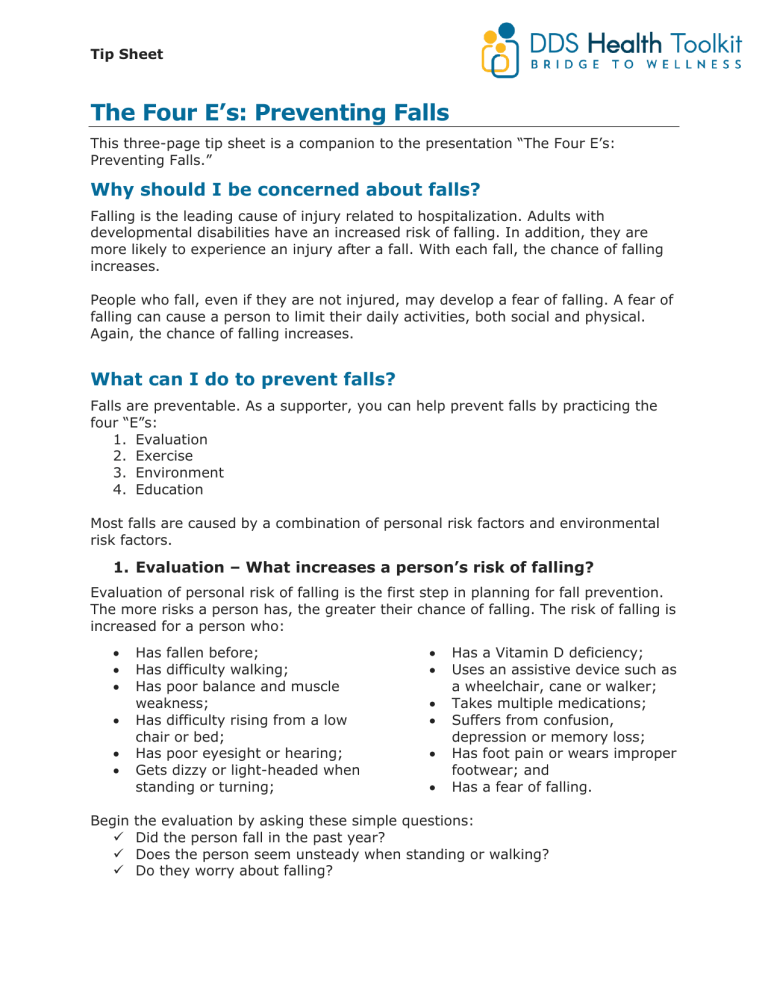
Tip Sheet The Four E’s: Preventing Falls This three-page tip sheet is a companion to the presentation “The Four E’s: Preventing Falls.” Why should I be concerned about falls? Falling is the leading cause of injury related to hospitalization. Adults with developmental disabilities have an increased risk of falling. In addition, they are more likely to experience an injury after a fall. With each fall, the chance of falling increases. People who fall, even if they are not injured, may develop a fear of falling. A fear of falling can cause a person to limit their daily activities, both social and physical. Again, the chance of falling increases. What can I do to prevent falls? Falls are preventable. As a supporter, you can help prevent falls by practicing the four “E”s: 1. Evaluation 2. Exercise 3. Environment 4. Education Most falls are caused by a combination of personal risk factors and environmental risk factors. 1. Evaluation – What increases a person’s risk of falling? Evaluation of personal risk of falling is the first step in planning for fall prevention. The more risks a person has, the greater their chance of falling. The risk of falling is increased for a person who: • • • • • • Begin ✓ ✓ ✓ Has fallen before; Has difficulty walking; Has poor balance and muscle weakness; Has difficulty rising from a low chair or bed; Has poor eyesight or hearing; Gets dizzy or light-headed when standing or turning; • • • • • • Has a Vitamin D deficiency; Uses an assistive device such as a wheelchair, cane or walker; Takes multiple medications; Suffers from confusion, depression or memory loss; Has foot pain or wears improper footwear; and Has a fear of falling. the evaluation by asking these simple questions: Did the person fall in the past year? Does the person seem unsteady when standing or walking? Do they worry about falling? Tip Sheet If the answer is “Yes” to any of these questions, further evaluation is needed. The next step is to talk to the person’s doctor about the person’s fall risk. Start with the completed risk checklist. Discuss medical conditions such as epilepsy or osteoporosis that may increase a person’s risk of falling and injury. Urinary tract infections (UTIs) can also cause disorientation and fatigue. Talk to the doctor to understand how medications may affect a person’s strength and balance. A person taking four or more medications has more than twice the risk of falling. Among other things, the doctor may recommend changing medication, consulting with a physical therapist, or taking other tests. Have an eye doctor check vision and renew eyeglass prescriptions each year. Assistive devices such as wheelchairs, canes, and walkers are meant to decrease risk. However, they may create an additional risk factor if not maintained or used properly. Make sure assistive devices are kept in good repair and are used correctly. Also, make sure the person has comfortable and proper footwear. 2. Exercise – How does it help? Everyone can benefit from exercise. Physical activities can all help to increase strength, mobility and balance for all individuals, but especially those at risk for falling. Exercise and physical activity help a person: • Maintain and improve their physical strength and fitness; • Improve their ability to do everyday activities; • Improve their balance; • Manage and improve diabetes, heart disease, osteoporosis and other diseases; and • Reduce feelings of depression and improve mood and overall wellbeing. Explore the community. Go for a walk. Find classes offered through the community. Getting people interested and committed to an exercise program isn’t always easy. Go4Life (https://go4life.nia.nih.gov/) provides motivational ideas for both support staff and persons at risk. The site also provides activities and exercises specifically designed to help people build balance and keep from falling. Work together to create a plan for safe physical activity (what, when, where) and do it. Everyone will benefit. 3. Environment – What can I do to increase home safety? Most falls happen in the home. Falls are often due to hazards that are easy to fix – but also easy to overlook. Look at floors, stairs and steps, kitchen, bathroom and bedrooms for: • Poorly lit rooms, hallways and stairwells; Tip Sheet • • • • • • • Broken or uneven steps or other surfaces; Throw rugs that can be tripped over; No handrails along stairs or in the bathroom; Broken or unstable furniture; Wet slippery surfaces; Unexpected obstacles; and Wires, cords and clutter. Identify and then remove or fix all environmental hazards. Most things are simple fixes that can literally save a person’s life. Also be aware of outdoor hazards such as uneven sidewalks, curbs, and slippery streets after a rain. Make sure people have shoes fit for the activity and weather. 4. Education – How do I bring fall prevention into practice? Make fall prevention a priority and learn how to recognize risks for falls and prevention steps to take. Learn to identify, remove, or fix environmental hazards, or report problems as needed. Develop a fall prevention plan for every person identified as being at risk. Implement the fall prevention plan with the person at risk and as needed, their doctor, physical therapist, and others. Make sure everyone knows what to do. Include: • A plan for regular physical activity that fits with the person’s interests and abilities; • A plan for proper use and maintenance of assistive devices; • An annual appointment with the person’s eye doctor to review vision; • An annual visit with the person’s doctor to review medications and talk about medical conditions that increase fall risk; and • A plan for regular re-evaluation of personal and environmental risks. Meet the person at risk on a regular basis to discuss implementation of fall prevention plans. Review documentation from any falls. Talk about what worked or didn’t work for the individual. Make changes to the plan as necessary. Continue to evaluate for personal and environmental risks. With some “frequent fallers,” causes of falls cannot always be identified. Instead, develop a plan of support to reduce as many risks of injury as possible. Remember the 4 E’s: Evaluation – Exercise – Environment – Education For additional information on fall prevention: • • Stop Falls - www.stopfalls.org Centers for Disease Control and Prevention - Stopping Elderly Accidents, Deaths and Injuries - www.cdc.gov/steadi


